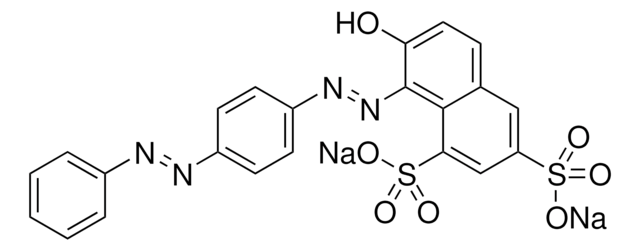210439
Acid Blue 113
Dye content 50 %
About This Item
Produits recommandés
Forme
powder
Composition
Dye content, 50%
λmax
566 nm
ε (coefficient d'extinction)
≥18000 at 563-569 nm in H2O at 0.02 g/L
Application(s)
diagnostic assay manufacturing
hematology
histology
Température de stockage
room temp
Chaîne SMILES
[Na+].[Na+].[O-]S(=O)(=O)c1cccc(c1)\N=N\c2ccc(\N=N\c3ccc(Nc4ccccc4)c5c(cccc35)S([O-])(=O)=O)c6ccccc26
InChI
1S/C32H23N5O6S2.2Na/c38-44(39,40)23-11-6-10-22(20-23)34-35-27-16-17-28(25-13-5-4-12-24(25)27)36-37-29-18-19-30(33-21-8-2-1-3-9-21)32-26(29)14-7-15-31(32)45(41,42)43;;/h1-20,33H,(H,38,39,40)(H,41,42,43);;/q;2*+1/p-2/b35-34+,37-36+;;
Clé InChI
XPRMZBUQQMPKCR-XGQONITOSA-L
Description générale
Code de la classe de stockage
11 - Combustible Solids
Classe de danger pour l'eau (WGK)
WGK 1
Point d'éclair (°F)
Not applicable
Point d'éclair (°C)
Not applicable
Certificats d'analyse (COA)
Recherchez un Certificats d'analyse (COA) en saisissant le numéro de lot du produit. Les numéros de lot figurent sur l'étiquette du produit après les mots "Lot" ou "Batch".
Déjà en possession de ce produit ?
Retrouvez la documentation relative aux produits que vous avez récemment achetés dans la Bibliothèque de documents.
Les clients ont également consulté
Notre équipe de scientifiques dispose d'une expérience dans tous les secteurs de la recherche, notamment en sciences de la vie, science des matériaux, synthèse chimique, chromatographie, analyse et dans de nombreux autres domaines..
Contacter notre Service technique










